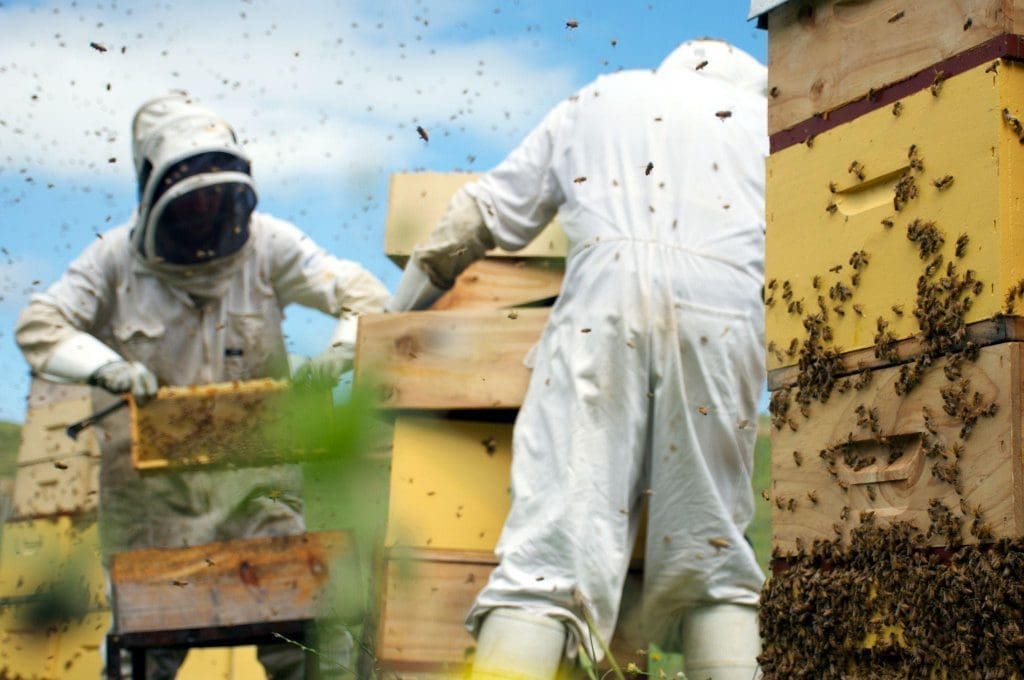
Honey is a common ingredient in baking and cooking. It can be spread on toast, or added to tea as a substitute for sugar. But what is honey really and how is it made? Read on to find out.
Honey is a sweet, sticky, viscous substance made by bees. If kept in an airtight container, honey is one of the few foods that doesn’t expire or go bad. Although, over time, it can lose some of its aroma and flavour, and it may crystallise. That said, if you leave honey unsealed in a humid environment, there is a high chance it will become contaminated and that will cause it to go off.
Honey has the same relative sweetness as ordinary sugar (sucrose), and gets its sweetness from the monosaccharides, fructose and glucose. The flavour, colour, and texture of honey depend on a number of factors, including the type of bee and the variety of flowers and pollens they encounter.

Honey is made from two ingredients: nectar and pollen. Bees collect both from flowers.
Nectar is a sweet liquid collected from the heart of a flower, whereas pollen is collected from the anther of the flower. Bees have specialised roles with only certain bees collecting pollen and others only nectar, depending on their job. The nectar or pollen can weigh up to 30% of the bee’s body weight.
Bees store the pollen in their “saddlebags” while flying home to the hive or moving from flower to flower. This allows them to pollinate one flower with pollen from another flower.
If bees need energy for themselves, they will open a valve in their nectar sac to allow some of the nectar to be converted to energy that they can use.

Once the nectar is brought back to the hive, it is made into honey. In this process, the nectar is passed from bee to bee via regurgitation, until it reaches the honeycomb. Bees rapidly flap their wings to speed up the evaporation of any water in the nectar so the honey becomes more viscous. This process drives the moisture content of the nectar down from about 70% to 20%.
The jelly-like substance that results is sealed in the comb storage cells along with liquid from the bee’s abdomen that is turned into beeswax. Bees use pollen to feed baby bees, and they store it in the hive when it is not in use.
Beekeepers wear protective suits when collecting honey. They pacify the bees using a bee smoker, which inhibits a bee’s pheromones, making them less aggressive. Beekeepers reach in and remove a portion of the honeycomb. Honey is extracted by crushing the comb by hand or by using machinery. Any debris and leftover beeswax are removed from the honey through a filtering process.
In the past, it was common practice to take all the honeycombs from the hive, which resulted in many bees being sacrificed due to starvation. Modern beekeepers typically leave a portion of the beeswax in the hive to allow the bees to feed on it throughout the winter. If they don’t want to leave any beeswax, they provide sugar water or crystalline sugar as a substitute food source for the bees.

Bees are an exceptionally important agricultural commodity, and they are under threat. The varroa destructor, also known as the varroa mite, is a deadly threat to bees. They spread viruses that cripple the bees’ ability to fly, gather food or reproduce. These nasty bugs are the size of a match head, and Australia is the only inhabited continent in the world that is varroa mite-free. There have been some scares, but so far, mite infestations have all been stopped at the ports (they tend to come in via ship), and Australia remains varroa-free for now.
In Australia, bees and their pollination services are valued at $8 billion per year, so a varroa mite infestation would not only be environmentally devastating, it would also hit the economy hard.
Try not to spray bees with pesticides. Bees just want to go about their days, ferrying pollen and nectar between plants and their hives. If you stay out of their way, there is a very low chance they’ll sting you.
Plant bee-friendly plants and leave water out on hot days. Set up your water bowl with “landing pads” such as corks or plants, so the bees have a place to land while getting a drink.
In short, be kind to the bees. Remember, some crops, such as avocados and apples, are completely reliant on honey bee pollination.
Although we may not be apiarists (beekeepers) at Chemwatch, we do have a wide range of skill sets. We can help you write SDS and Risk Assessments, create labels and Heat Maps for you, and assist in storing your chemicals in a safe manner. Contact sales today on (03) 9573 3100 or at sa***@*******ch.net.
Sources: